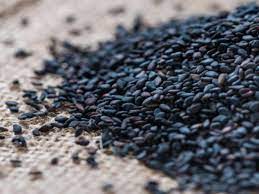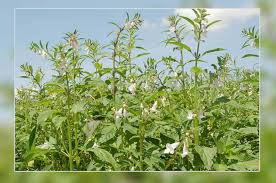Sesame
The sesame tree is about one m. This tall and straight-growing perennial (one-year-old) and hairy herb with branches is native to Africa and may have been brought by humans who migrated from there to India in ancient times. It may have been cultivated in the ancient Indus Valley Civilization, as evidenced by burnt sesame seeds found at Harappa excavations (3600–1750 BCE). Due to the ancient cultivation of sesame in the continents of Asia and Africa, its origin is disputed. Some experts believe that Abyssinia in Africa may have been the primary origin of sesame’s wild ancestors, and cultivated varieties may have originated in central India, Assam, and Burmese, with a secondary origin of cultivated varieties in the central and eastern highlands of China. The major types there are scabies. Apart from these, there are two other major sources: one is Punjab, Kashmir, Pakistan and Afghanistan, and the other is Iran and Turkey, regions of Asia Minor.

Another subspecies of sesame (C. bicarpellatum) is mainly cultivated here. From these two types of (primary and secondary) sources, sesame moved in two directions: eastward through China and Indochina to Japan, and westward to the Mediterranean region. Sesame is one of the oldest cultivated grains in India and is mentioned in the Taittiriya and Shonak Samhitas. It is also mentioned as ‘Homadhya’ and ‘Pitrutarpan’. The names of sesame in many languages of India appear to be related to the Sanskrit name ‘Til’. Tail (oil) is derived from the Sanskrit word ’til’. Hindus still use sesame seeds in many religious rituals. Taking into account the fact that ‘Tilgul’ wishes to each other on the day of Sankranthi, it makes sense that Til (Sesame) is an Indian medicine. Wild sesame trees are found in Thane and Kolaba districts. C. Lacinatum is found growing as a weed in malarana and spreads over the ground. A total of six species of Sesamum genus are found in India. C. The body cells (cells) of the indicum species contain 26 pigments (thread-like elements that carry genetic traits from one generation to the next), while C. Lacinatum has 32 of them. Sesame is cultivated throughout India (up to 1,200 m altitude) except in Karwar and Konkan and also in Pakistan, Baluchistan and Waziristan.
Must read – Palmyra palm
The its plant has simple, large (7·5–12·5 cm) opposite, thin, generally hairy leaves that are slightly divided (segmented) near the ground and toothed and elongated in the upper part of the stem. Hairs on all plants are pimentum (containing glands that secrete a sticky substance). Axils of the leaves bear white-pink flowers in panicles or solitary. The corolla is double-lipped (like two lips) with yellow markings. Bond (fruit) oblong globose, erect, 2·5 cm. It is long and square and cracks from top to bottom. Seeds (sesame) are small (2·5–3 X 1·5 mm), flat, dark brown, ovate or white. It is an experience that the lighter the color, the more and cleaner the oil in them. Other general physical symptoms are as described in the sesame family.
Cultivated area: According to the Food and Agriculture Organization report of 1970, the total world area of sesame in that year was 57·1 lakh hectares and the production was 18·66 lakh tonnes. India had the largest area under this crop (42·03%) and also ranked first in production (23·6%). Apart from India, China, Sudan, Mexico and Burma are the major sesame producing countries. Under them, this crop is cultivated in small quantities in the countries of Venezuela, Uganda, Nigeria, Pakistan and Turkey.

It is the sixth largest crop in the world under oilseeds both in terms of total area and production. Sesame accounts for 5·6% area and 2·7% production of the total oilseeds area. However, the main reason why it is an important crop in sesame growing countries is its durability and high quality oil. Even in India it ranks third after groundnut and mustard.
Medicinal Properties
Sesame seeds are astringent, analgesic, nutritious, diuretic (urinary) and lactiferous and effective against piles. Black sesame is amenorrhoeic (initiator of menstruation) and its poultice is applied on wounds. its seeds are divided and applied to the burnt or burnt areas. Sesame oil is given along with other medicines for dysentery and urinary disorders. Consuming sesame oil has been recommended to reduce the risk of heart disease. A decoction of sesame seeds with linseed is aphrodisiac. Fresh leaves are useful in inflammation of the mucous (mucous) part of the kidneys and bladder. Leaves are applied externally (divided) on complaints of eyes and skin. Extracts of leaves and roots are used to wash hair for hair growth. The mucilaginous juice of the plant is useful in killing hair lice.
Like to read – Tandulja
Uses
(1) Among the sesame produced in India, about 78% of sesame oil is extracted. Ms. 20% for domestic use and Rs. 2% are used for sesame seeds. Sesame seeds are shelled before being used as food. In the home method of removing the shells, the sesame seeds are soaked overnight and the next day they are dried a little and rubbed on a rough surface to remove the shells and then they are cleaned. An improved commercial method consists of a 0·6% solution of caustic soda at 96°C. After immersing the sesame in the temperature for 1 to 2 minutes and then washing it in water, the shells come off. Roasting the shelled sesame seeds on a griddle creates a distinctive taste of sesame seeds.
Peeled sesame seeds are used in sweets and other foods. In Maharashtra, there is a method of applying sesame to millet bread. In America and European countries, sesame seeds are used to spread on bread and baked goods. In Venezuela, roasted sesame seeds are split and mixed with milk and sugar to make pudding.
(2) Oil : 20 kg in bull dung in 2 hours. Sesameoil can be extracted. Of the 46 to 52% oil in the seed, 36 to 38% of the oil comes from the bullion and 40 to 42% from the mill. While extracting oil from cow dung, taro and kakvi are used in small quantities. This makes the oil taste better. Lathes formerly used water presses, but now use screw-presses of low and medium power.
82% of sesameoil produced in India is used for edible oil. It is used in a variety of foods, to make vegetable ghee, as well as in the manufacture of soaps, cosmetics, perfumes, pesticides and medicinal products. As this oil does not spoil quickly, it is used to make aromatic oil (by soaking aromatic flowers in oil). Oil soluble drugs are also used for injecting into the body. Other vegetable oils are mixed with sesameoil to make them more durable.
(3) Fodder : It is a nutritious animal feed but it spoils quickly. It can be used to make powders, gums, edible proteins and calcium proteinate tablets. Pendi is used in cooking in some parts of India (especially the poorer classes).

Benefits of Sesame Oil
1. Rich in antioxidants
Sesameoil contains sesamol and sesaminol. These are two antioxidants. which can have a powerful effect on your health. These help in reducing the damage caused to the cells in the body by free radicals. The accumulation of free radicals in cells can cause inflammation. Which causes many health problems. Studies on mice have shown that consuming sesame oil can protect heart cells from damage.
2. Reduces inflammation
Chronic inflammation can be harmful and lead to many diseases, so it is important to limit it as much as possible. Sesame oil has long been used in traditional Taiwanese medicine for its anti-inflammatory properties. It is used to reduce joint inflammation and relieve toothache.
Read also – Gummy gardenia ( Dikemali )
3. Beneficial in joint pain
Don’t go by the size of its seeds as sesame seeds contain good amount of vitamins and minerals. It contains good amounts of copper, zinc, magnesium, iron and calcium. its oil, however, does not contain as many nutrients as sesame seeds because some of its nutrients are lost during the extraction process. Copper has anti-inflammatory properties that help reduce arthritis pain, reduce joint swelling, and strengthen bones.
4. Blood pressure becomes low
For a long time, its oil was commonly used in cooking. According to research by an Indian researcher published in the Yale Journal of Biology and Medicine, “Consumption of sesame oil as an edible oil lowers blood pressure. Decreases lipid peroxidation and increases antioxidant status in hypertensive patients.”
5. Nourishes the skin
It helps nourish the skin due to its nourishing properties and sun-protective properties. It is also an ideal oil for taking good care of skin and hair. You can include it in your beauty routine without any hesitation. Massaging with sesame oil before bathing increases blood circulation in the body and moisturizes the skin. It reduces the redness of the skin and helps reduce the problem of acne.
6. Heart is healthy
Research has shown that its oil contains unsaturated fats that are good for heart health. Sesame oil contains 82% unsaturated fats. In particular, it is rich in omega-6 fatty acids. Omega-6 fatty acids are a type of polyunsaturated fat that should be in your diet and help prevent heart disease. A study conducted on rats showed that sesame oil is useful in preventing heart diseases.

7. Help fight stress
Sesame oil contains an amino acid known as tyrosine, which is directly linked to serotonin activity. Serotonin is a neurotransmitter. which affects our mood. Its imbalance can lead to depression and stress. According to experts, eating foods that help in the production of serotonin can help create positive emotions and help fight stress.
8. Helps improve oral health
Oil pulling is an ancient Ayurvedic technique that can help improve your oral health. It prevents the accumulation of plaque in the teeth and gums. Take a spoonful of sesame oil in your mouth on an empty stomach in the morning and swish it around your mouth for 20 minutes. Then spit and rinse. It can help remove toxins from the body.
Source – Marathi vishwakosh
Read More –
Faq –
1 What is the origin of sesame cultivation ?
2 What are the uses of sesame seeds ?
3 What are the benefits of sesame seeds ?